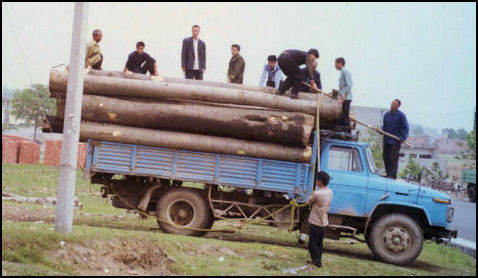TIMBER IN CHINA

Deforestation in Yunnan Forestry products, measured in annual roundwood production, also abound. In 2004 China produced an estimated 284 million cubic meters of roundwood, the world’s third largest supplier after the United States and India, or about 8.5 percent of total world production. From the roundwood, some 11.3 million cubic meters of sawnwood are produced annually. [Source: Library of Congress]
China is quickly becoming the world’s leading importer of wood from tropical developing countries like Indonesia, Myanmar and Papua New Guinea, where illegal logging is rampant. It also imports large amounts of wood from Russia and Canada. Much of the illegally logged timber from Southeast Asia ends up in China A cargo ship from New Guinea arrives every week at a port near Shanghai, loaded with 300,000 cubic meters of merbau logs. A third of the exports from logging mills deep in the Amazon rain forest end up in China, where much f it used top-quality hardwood floors. See Rain Forest Under World Topic
Demand from China for timber exploded in the early and mid 2000s much of it because of the rise of the cheap furniture in China that produces furniture for the American, European and Japanese markets. Very little money ends n the hands of those who cut the wood. One study founded that hardwood harvested at $11 a cubic meter in Papua Ne Guineas increases in value to $240 a cubic meter in China.
According to a report by the U.S.-bases Forest Trends and the International Forestry Research, China has captured a third of the global trade in furniture in the past eight years, with wood product exports to the United States and the European Union having increased almost 900 percent between 1998 and 2005 with 40 percent of all wood product imports ending up in the United States.
Increased Demand for Timber
Some say that lumber could become the next commodity to soar in price as a result of Chinese demand. In one projection the price of lumber is predicted to rise 300 percent based on the need for wood to fuel the mass urbanization of China in 2010s.Already around 20 million Chinese move to the cities every year and that figure could rise. [Source: Leo Lewis, Times of London, January 2010]
One of the major factors spurring demand for lumber is a new building code in Shanghai for wood frame structures. Wood will be needed for lumber to build new houses but also to furnish them with new tables, chairs and desks.
Countries with vast forests — namely Russia and Canada’stand to gain handsomely from a surge in demand. It could be bad news for China’s dwindling forest and rain forest in tropical countries that are already under pressure from both legal and illegal logging.
Paper in China
China is the number No. 2 paper consumer in the world after the United States Paper consumption increased from 14.6 million tons in 1990 to 48 million tons in 2003 and is expected to rise to 68.5 million tons in 2010. That would raise China’s demand for wood pulp to 15.1 million tons — the equivalent of about half the Brazilian Amazon current annual timber harvest — for 9.2 million in 2003.
Top 5 paper producers (millions of tons per year): 1) USA (71.5); 2) Japan (28); 3) Canada (16.4); 4) China (13.7); 5) Germany (11.8).
If Chinese were to consume the same amount of paper as Americans, let say in 20 years, when China’s population reaches 1.45 billion, then China would consume double the world’s current production of 161 million tons.

Logging truck
Paper in China grass, rice stalks or bamboo in China. Paper is made from wood pulp in the United States
As demand increase, China must look increasingly abroad in part because of logging bans at home and the closure of small, polluting mills that used agricultural residues
China’s demand for paper has caused prices for recycled paper to rise, sparking paper battles in Japan (See Japan). One of China’s richest people — a woman named Zhang Yin — made her fprtune importing recycled paper from the United States (See Rich, People and Life).
Chinese demand for paper has also fueled paper mill expansion in China and accelerated deforestation in places like Indonesia and the Mekong region . In some cases the mills are built without a source of raw material worked and this in turn provides an incentive to illegally log sources of raw materials such virgin forests.
Rubber in China
China is the world’s leading consumer of rubber (3,640,500 tons). China is now a large vehicle and tire producer and consumer.
Image Sources: 1) All Posters com http://www.allposters.com/?lang=1 Search Chinese Art ; 2) Louis Perrochon ; 3) University of Washington; 4, 5) Nolls China website http://www.paulnoll.com/China/index.html ; 6) Mongabey
Text Sources: New York Times, Washington Post, Los Angeles Times, Times of London, National Geographic, The New Yorker, Time, Newsweek, Reuters, AP, Lonely Planet Guides, Compton’s Encyclopedia and various books and other publications.
Last updated July 2015
